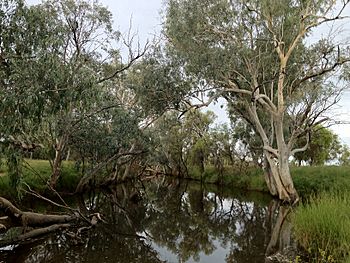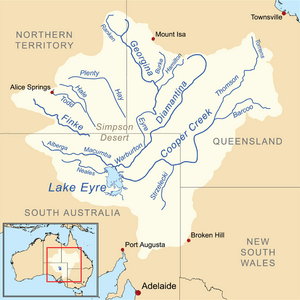Barcoo River facts for kids
Quick facts for kids Barcoo River |
|
|---|---|

Barcoo River at Tambo, 2012
|
|

Map of the Lake Eyre Basin showing Barcoo River
|
|
| Country | Australia |
| State | Queensland |
| City | Blackall, Isisford, Tambo, Queensland |
| Physical characteristics | |
| Main source | Warrego Range east of Tambo, Central Queensland |
| River mouth | confluence with the Thomson River north of Windorah |
| Basin features | |
| River system | Cooper Creek, Lake Eyre basin |
The Barcoo River is a river in western Queensland, Australia. It starts in the Warrego Range and flows towards the southwest. The Barcoo River joins with the Thomson River to create Cooper Creek.
Unlike many rivers in eastern Australia that flow to the sea, the Barcoo River's water flows inland. It eventually reaches Lake Eyre in central Australia, which is a large salt lake. The river is also known for marking a kind of boundary in the Australian outback. People used to say that west of the Barcoo, the land was very wild and undeveloped.
Several towns are located along the Barcoo River. These include Blackall, Isisford, and Tambo. The river also forms the southern edge of Welford National Park. A structure called the Isisford Weir has been built on the Barcoo River.
Contents
Discovering the Barcoo River
The first European explorer to see the Barcoo River was Thomas Mitchell in 1846. He first called it the Victoria River. Mitchell thought it was the same river that J. C. Wickham had named Victoria River in 1839.
Later, another explorer named Edmund Kennedy renamed the river. He used a name given to him by the local Aboriginal people. This is how the river got its current name, Barcoo.
Barcoo Grunter Fish
The Barcoo grunter is a type of freshwater fish. It is also known as jade perch. This fish lives in rivers in the eastern Northern Territory and northern Queensland. It can also be found in the Lake Eyre basin of central Australia.
The Barcoo grunter is a popular fish for eating. Because it tastes good, it is often raised on fish farms. These farms use special ponds or tanks to grow the fish.
Life in the Outback: Barcoo Legends
Life in the Australian outback used to be very tough. The Barcoo River area was known for some unique challenges.
One old saying is "the Barcoo salute". This phrase describes how people in the outback would wave their hand to brush away the many flies from their face. It was a very common action because flies were always present.
In the past, people in the Barcoo district also talked about certain health problems. These included "Barcoo rot," which was a skin problem with sores. Another was "Barcoo fever," which caused fever, nausea, and vomiting. These issues were often linked to the harsh conditions, lack of fresh food, and sometimes unsafe drinking water. Luckily, with better food supplies and cleaner water today, these specific problems are now very rare.
See also
 In Spanish: Barcoo para niños
In Spanish: Barcoo para niños
Images for kids



